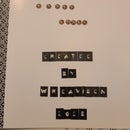Introduction: Pallet Wood Raised Garden
I had some free pallets in the backyard that were being stored and decided to get the eye soars out of the yard. Of course I had been storing them for a project or to make something useful as an up cycle project.I didn't want to tear them apart and toss them out...
After looking on line at the cost of raised gardens I had a great idea! I would tear apart the pallets and use the wood for a raised garden and once I got started, tearing them apart, I decided they would make great, small planter boxes. This would be easy to have a small garden on the side of the house what would be free in cost.
So, pallets are very unsafe, nails and wood splinters can be dangerous things when you are ripping apart the pallet... Wear eye protection and gloves to protect your hands!
NOTE:
"Pallets are NOT SAFE to use for growing food. Pallets are treated with all kinds of nasty chemicals to keep them from rotting, to kill pests, etc. Pressure treated wood of any kind, particularly pallet wood, is not suitable for growing consumables. The chemicals WILL leach out into your food and it’s not something you want to ingest. It’s a great project, but maybe fill it up with flowers and grasses or anything not destined for your stomach!" Added comment by MuzicMaker on 6/25/2020
If food is to be grown line the dirt or burlap with plastic or something to block the leaching of harmful chemicals!
Supplies
Screws
Nails
pallets
burlap
potting soil
drill and drill bits
hammer
saws all
scrap wood (2x4s)
Step 1: Cut Each Section
Remove a few boards for the bottoms of the planters and then cut each section to form the front and back walls of each planter you want to make. Use the extra 2x4s to create a section wall so that there is support for the bottom to be nailed into.
Step 2: Burlap to Keep the Dirt In
I used sections of burlap to keep the dirt in each section. I used a staple gun and attached the fabric to the front and back. If there was an open area, I left it and will place a large rock to fill the opening so the dirt would remain in each of the sections.
Step 3: Some Fun Decorations
I decided to add some fun decorations to the front of each planter... bottle caps and plates made a easy addition.
I used a nail to punch a hole in the bottle caps then used screws to screw them into the wood.
Step 4: Legs to Raise It Up
Metal bars were used to hold the side of each planter and formed a lean to on the brick wall.
I drilled holes into each leg at the same height and then was able to use long screws to pin them on the planters.
Step 5: Week Five
I went back and now have added string for the plants to grow and grab onto... tomatoes and green beans need to have some support as they get taller and love to hang onto these supports.I used a metal wire to put the string on... looks ugly but I think it will work! I love I did all of this for free and that my seeds I bought at the hardware store really grew fast... the most expensive item was the planting soil... $12 USD for a big bag... and the burlap was from a different project (re upholstering car seats!) and it was $10 USD for a roll of about 30 feet.




